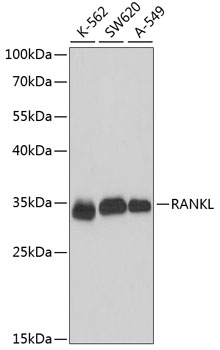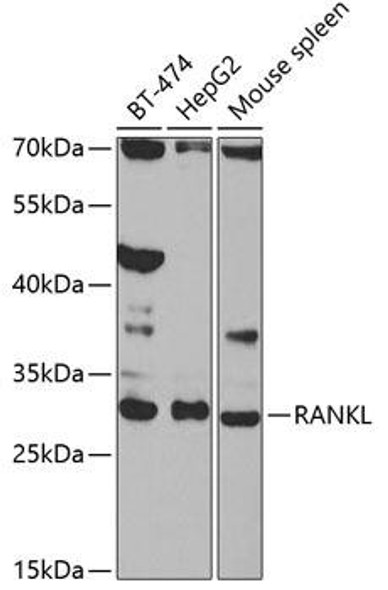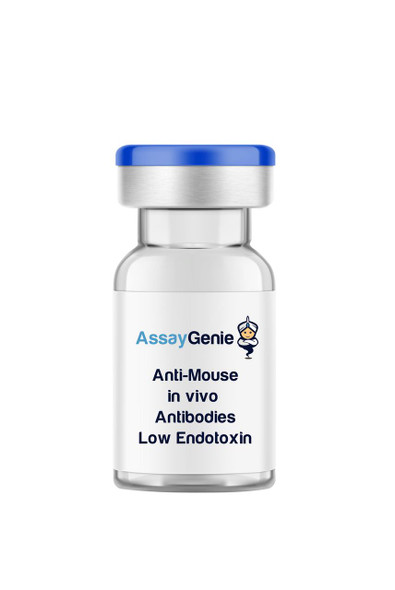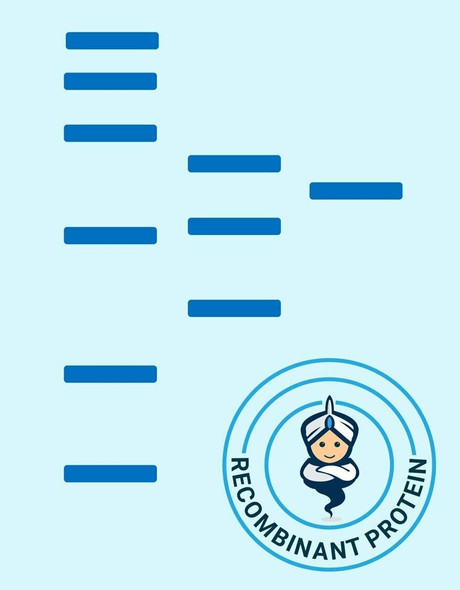Anti-RANKL Antibody (CAB16326)
- SKU:
- CAB16326
- Product type:
- Antibody
- Reactivity:
- Human
- Host Species:
- Rabbit
- Isotype:
- IgG
- Antibody Type:
- Polyclonal Antibody
- Research Area:
- Developmental Biology
Description
| Antibody Name: | Anti-RANKL Antibody |
| Antibody SKU: | CAB16326 |
| Antibody Size: | 20uL, 50uL, 100uL |
| Application: | WB |
| Reactivity: | Human |
| Host Species: | Rabbit |
| Immunogen: | Recombinant fusion protein containing a sequence corresponding to amino acids 78-317 of human RANKL (NP_003692.1). |
| Application: | WB |
| Recommended Dilution: | WB 1:500 - 1:1000 |
| Reactivity: | Human |
| Positive Samples: | K-562, SW620, A-549 |
| Immunogen: | Recombinant fusion protein containing a sequence corresponding to amino acids 78-317 of human RANKL (NP_003692.1). |
| Purification Method: | Affinity purification |
| Storage Buffer: | Store at -20°C. Avoid freeze / thaw cycles. Buffer: PBS with 0.02% sodium azide, 50% glycerol, pH7.3. |
| Isotype: | IgG |
| Sequence: | RISE DGTH CIYR ILRL HENA DFQD TTLE SQDT KLIP DSCR RIKQ AFQG AVQK ELQH IVGS QHIR AEKA MVDG SWLD LAKR SKLE AQPF AHLT INAT DIPS GSHK VSLS SWYH DRGW AKIS NMTF SNGK LIVN QDGF YYLY ANIC FRHH ETSG DLAT EYLQ LMVY VTKT SIKI PSSH TLMK GGST KYWS GNSE FHFY SINV GGFF KLRS GEEI SIEV SNPS LLDP DQDA TYFG AFKV RDID |
| Gene ID: | 8600 |
| Uniprot: | O14788 |
| Cellular Location: | Cell membrane, Cytoplasm, Secreted, Single-pass type II membrane protein, Single-pass type II membrane protein |
| Calculated MW: | 27kDa/30kDa/35kDa |
| Observed MW: | 35kDa |
| Synonyms: | TNFSF11, CD254, ODF, OPGL, OPTB2, RANKL, TNLG6B, TRANCE, hRANKL2, sOdf |
| Background: | This gene encodes a member of the tumor necrosis factor (TNF) cytokine family which is a ligand for osteoprotegerin and functions as a key factor for osteoclast differentiation and activation. This protein was shown to be a dentritic cell survival factor and is involved in the regulation of T cell-dependent immune response. T cell activation was reported to induce expression of this gene and lead to an increase of osteoclastogenesis and bone loss. This protein was shown to activate antiapoptotic kinase AKT/PKB through a signaling complex involving SRC kinase and tumor necrosis factor receptor-associated factor (TRAF) 6, which indicated this protein may have a role in the regulation of cell apoptosis. Targeted disruption of the related gene in mice led to severe osteopetrosis and a lack of osteoclasts. The deficient mice exhibited defects in early differentiation of T and B lymphocytes, and failed to form lobulo-alveolar mammary structures during pregnancy. Two alternatively spliced transcript variants have been found. |
| UniProt Protein Function: | TNFSF11: Cytokine that binds to TNFRSF11B/OPG and to TNFRSF11A/RANK. Osteoclast differentiation and activation factor. Augments the ability of dendritic cells to stimulate naive T-cell proliferation. May be an important regulator of interactions between T-cells and dendritic cells and may play a role in the regulation of the T-cell-dependent immune response. May also play an important role in enhanced bone-resorption in humoral hypercalcemia of malignancy. Homotrimer. Up-regulated by T-cell receptor stimulation. Highest in the peripheral lymph nodes, weak in spleen, peripheral blood Leukocytes, bone marrow, heart, placenta, skeletal muscle, stomach and thyroid. Belongs to the tumor necrosis factor family. 3 isoforms of the human protein are produced by alternative splicing. |
| UniProt Protein Details: | Protein type:Membrane protein, integral Chromosomal Location of Human Ortholog: 13q14 Cellular Component: extracellular space; integral to plasma membrane; cytoplasm; extracellular region Molecular Function:cytokine activity; tumor necrosis factor receptor superfamily binding; tumor necrosis factor receptor binding Biological Process: ossification; positive regulation of I-kappaB kinase/NF-kappaB cascade; positive regulation of osteoclast differentiation; cytokine and chemokine mediated signaling pathway; mammary gland epithelial cell proliferation; osteoclast differentiation; activation of JNK activity; positive regulation of corticotropin-releasing hormone secretion; positive regulation of homotypic cell-cell adhesion; activation of NF-kappaB transcription factor; calcium ion homeostasis; monocyte chemotaxis; positive regulation of protein kinase B signaling cascade; positive regulation of MAP kinase activity; organ morphogenesis; tumor necrosis factor-mediated signaling pathway; positive regulation of bone resorption; immune response; positive regulation of transcription from RNA polymerase II promoter; positive regulation of transcription factor activity; positive regulation of T cell activation; protein homooligomerization; bone resorption Disease: Osteopetrosis, Autosomal Recessive 2 |
| NCBI Summary: | This gene encodes a member of the tumor necrosis factor (TNF) cytokine family which is a ligand for osteoprotegerin and functions as a key factor for osteoclast differentiation and activation. This protein was shown to be a dentritic cell survival factor and is involved in the regulation of T cell-dependent immune response. T cell activation was reported to induce expression of this gene and lead to an increase of osteoclastogenesis and bone loss. This protein was shown to activate antiapoptotic kinase AKT/PKB through a signaling complex involving SRC kinase and tumor necrosis factor receptor-associated factor (TRAF) 6, which indicated this protein may have a role in the regulation of cell apoptosis. Targeted disruption of the related gene in mice led to severe osteopetrosis and a lack of osteoclasts. The deficient mice exhibited defects in early differentiation of T and B lymphocytes, and failed to form lobulo-alveolar mammary structures during pregnancy. Two alternatively spliced transcript variants have been found. [provided by RefSeq, Jul 2008] |
| UniProt Code: | O14788 |
| NCBI GenInfo Identifier: | 12643360 |
| NCBI Gene ID: | 8600 |
| NCBI Accession: | O14788.1 |
| UniProt Secondary Accession: | O14788,O14723, Q96Q17, Q9P2Q3, |
| UniProt Related Accession: | O14788 |
| Molecular Weight: | 30,523 Da |
| NCBI Full Name: | Tumor necrosis factor ligand superfamily member 11 |
| NCBI Synonym Full Names: | tumor necrosis factor (ligand) superfamily, member 11 |
| NCBI Official Symbol: | TNFSF11 |
| NCBI Official Synonym Symbols: | ODF; OPGL; sOdf; CD254; OPTB2; RANKL; TRANCE; hRANKL2 |
| NCBI Protein Information: | tumor necrosis factor ligand superfamily member 11; osteoprotegerin ligand; osteoclast differentiation factor; TNF-related activation-induced cytokine; receptor activator of nuclear factor kappa B ligand; receptor activator of nuclear factor kappa-B ligand |
| UniProt Protein Name: | Tumor necrosis factor ligand superfamily member 11 |
| UniProt Synonym Protein Names: | Osteoclast differentiation factor; ODF; Osteoprotegerin ligand; OPGL; Receptor activator of nuclear factor kappa-B ligand; RANKL; TNF-related activation-induced cytokine; TRANCE; CD_antigen: CD254Cleaved into the following 2 chains:Tumor necrosis factor ligand superfamily member 11, membrane form; Tumor necrosis factor ligand superfamily member 11, soluble form |
| UniProt Gene Name: | TNFSF11 |
| UniProt Entry Name: | TNF11_HUMAN |







